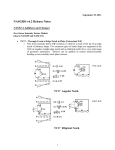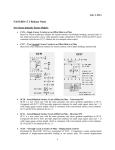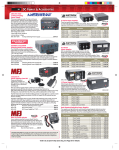Download « Zen+k » A computer code for phase diagram prediction User's guide
Transcript
« Zen+k » A computer code for phase diagram prediction User’s guide Bernard GUY and Jean-Marie PLA Ecole Nationale Supérieure des Mines de Saint-Etienne 158, Cours Fauriel, 42023 Saint-Etienne Cédex 2, France e-mail: [email protected], [email protected] Version 3.0, June 1999 Contents 1. Foreword, notations 2. Data input and display (« File » and « Display ») 3. Correction of data (« Edit ») 4. Calculation (« Run ») 5. Output (« Display ») 6. Printing 7. Options 8. Examples 9. References 2 « Zen+k »1 A computer code for phase diagram prediction Version 3.0 User’s guide The computer code was written in Pascal by J.M. Pla on the basis of a collaborative work with B. Guy (Guy and Pla, 1997a and b). The present non-commercial version of the code is given free of charge. People should refer to Guy and Pla (1997a and b) in any publication using the code. The authors are not responsible for problems that may arise from the use of the program. They will be pleased to receive any questions appearing from this version of the code. Next version of the program may be sent upon request. The current user’s guide gives a brief account of the main capacities of the program, version 3.0. 1. Foreword, notations Zen+k constructs linear approximations of several types of phase diagrams for pure compounds, such as (T, p), (µ, µ), (X, T) diagrams and so on, and needs a limited amount of thermodynamic data. It fully exploits the algebraic properties of the equations ruling thermodynamic equilibrium and treats the diagram as a unique object in multidimensional space, and not as the addition of independent lines; it thus avoids algebraic redundancy obtained by computing each reaction separately. The positioning with respect to the multidimensional object gives all stability information in the same time. Zen+k allows to discuss many qualitative aspects of phase diagrams, including the organization of reactions around invariant points, the organization of invariant points in the diagram, the nature and stability/metastability of phase associations as a function of control parameters, the influence of data on diagram topology and so on. It gives a quick overview of the structure, or « topology » of the diagrams. In the case of chemical potential (« predominance ») diagrams the program gives the exact solution. Zen+k program is based on an original thermodynamic concept, exposed in Guy and Pla (1997a), namely the « affigraphy » concept. Systems will be considered with n independent 1 Name of the program was chosen as a tribute to E.A. Zen; this author discussed methods to predict phase diagram structure, mostly for n + 2 and n + 3 phase systems (e.g. Zen, 1966a and b); our method may deal with n + k phase systems with k arbitrary. 3 chemical components and n + k phases in total; in the present approach, these have fixed composition (pure compounds, one species per phase). Basically, affigraphy is generated by the n + k row vectors of a chemical reaction matrix of the system, where reactions are written in columns; they construct a generalized diagram in duality with chemography. Chemography is the representation of the phases in the n-dimensional composition space (units: numbers of moles of the phases in the system, vector xi); in the affigraphy, the (standard) chemical affinities of the dissociation of the phases into elementary compounds are represented as Ai = -∆G (i) (P,T) = gi - µi, where gi(P, T) is Gibbs molar free energy of phase i and µi chemical potential of phase i. At equilibrium, so-called complementarity relation A.x = 0 holds with xi > 0, Ai = 0 (gi = µi), for the present phases xi = 0, Ai > 0 (µi < gi), for the absent phases Affigraphy is thus a space of « absent phases » and affigraphy vectors are « absent phase vectors ». According to a « fundamental theorem » exposed in Guy and Pla (1997a), the phase diagrams are obtained by intersecting by appropriate two-dimensional planes the n + k absent phase vectors inside the k-dimensional affigraphy. Invariant points (resp.univariant lines) are the traces on the planes of the (k-2) (resp. (k-1))-dimensional subspaces spanned by these vectors. The coordinates of the representative point of the system in the k-dimensional space provides information on the nature and stability of the phase associations. Notation of stability indices Different associations of phases co-exist at invariant points, along univariant lines or inside divariant domains of the diagrams. In the affigraphy approach, the stability of an association of phases such as A, B, C, D... or ABCD... is obtained by the properties of the set of absent phases EFGH... with respect to the whole set. This last set is written between brackets as (EFGH); in the affigraphy approach, each of the lacking phases is given a positive or negative sign in the kdimensional space in relation to the sign of the corresponding affinity. For example, if phase F is taken as -F, this means that AF < 0 and F should be present. The complete set of absent phases may be noted as for example (-E,-F,G,-H). The three negative signs of the last association indicate that ABCD is triply metastable. By convenience, the foregoing group of absent phases will be labeled (G-EFH) where symbol « - » separates the group of positive phases from that of the negative ones. If all the absent phases are positive, the labeling is (EFGH-), and if all are negative it is (-EFGH). The lowest stability level corresponds to the most stable association (all absent phases positive, stability index 0), and the highest stability level to the least stable or most metastable association (all absent phases negative, stability index k - 1). In the diagrams generated by Zen+k, the invariant points are labeled by the names of the absent phases in the corresponding associations. The knowledge of the phases present is obtained by 4 complementation to the absent phases. In the program outputs, only the invariant points are labeled, except in the case when k = 2 where univariant lines are labeled. The word stability is a characteristic of the absent phases of one given association (they would like to enter the basis, they are stable or not). By duality, the word « negativity » is a characteristic of a present phase association in composition type diagram. This lies on a generalization since sme of the phases may be in negative quantity. Status of compounds Following the terminology used in Petrology, inert (i) elements will be those for which a conservation constraint holds (closed system behavior), mobile (m) those for which no conservation constraint hold and whose chemical potential (or partial pressure for gases, or activity for solutes etc.) controls the spatial variation of the phases of the system (open system behavior); and perfectly mobile (pm) those « abundant » elements whose potential has the same value everywhere. Practically these last components may not be written in the composition matrix. Choices made in the representation of stabilities of phase associations in mixed type diagrams In order to start the program, user must select file « Zen+k.exe » and activate it. Other files stored are useful for running main program; examples bear suffix « .psy » (for physical system). In the following, the names written in italics and in quotes, such as « File », refer to commands in the menus. The user may select the command by typing active (yellow) letter or by selecting the item by use of keyboard arrows and pressing « Return ». A systematic inventory of the commands is not presented here but rather those most useful in the natural order of a session. Examples are discussed in Sect. 8. 2. Data input and display (Menu « File » and « Display ») To begin a new problem, command « File » must be chosen in the main menu, then « New » to enter the data. A name is given to the problem. The data may be defined within a « Composition » or « Reaction » matrix. Composition matrix C 5 Values of n and k must be given, so as reference temperature and pressure Tr and Pr for 2 thermodynamic data (default values 298.15° K and 1 bar; units: 1 k° K = 1000° K and 1kb) . Names of independent chemical components and names and compositions of the phases are indicated. For convenience in the diagram display, only one letter is chosen for each phase or component label; the program keeps in memory the whole name of the phases and components. The list of the correspondences between one letter symbols and item names is displayed by pressing « S ». In the composition matrix, phases are written in columns; three thermodynamic data are needed for each phase: - reference molar Gibbs free energy gr = g(Tr, Pr) at chosen reference temperature and pressure (unit: kJ/mol.), - molar entropy s at Tr (unit: J/mol.° K, equivalent to kJ/mol.k° K) and - molar volume v (unit: J/mol.bar, equivalent to kJ/mol.kb). Note that molar entropy is manipulated with a sign « - » added by the program. A prefix i is assigned by default to each component in the matrix: i means « inert » as explained above; the status of components may be changed to m (menu « Edit » / « Mobility »). All the foregoing permanent composition and thermodynamic information are called the « data », to be modified in the « Edit » menu (see Sect.3). Data need be implemented whatever type of diagram will be 3 constructed . Admissible values of n and k. Although the structure of the program is valid for any value of n and k, these parameters are limited to n + k ≤ 13 in the present version of the program. For higher values, the number of phases is too great for convenient display. Display of composition matrix As is shown in the display of the composition matrix (« Display » / « Matrices » / « Composition »); all session parameters may be subject to modification in the commands « Run » / « Parameters » (see Sect. 4). If some elements have been chosen as mobile (« Edit » / « Mobility »), a prefix m is added to the corresponding label in the table. * At last, a line labeled « g » is added to composition matrix; it corresponds to the g of the phase for current pressure and temperature values that may differ from reference values (« g » line also takes into account the chemical potentials of the mobile elements: thus, for phase j, gj = gjr (T - Tr)sjr + (p - pr)vj - (µi - µir)cij, where cij is number of moles of component i in one mole of phase j). Reference and parameter default value for chemical potential of component i is zero. * 2 Linearization procedure will be done from this reference data. Although not needed to construct chemical potential diagrams, molar entropies and volumes must be indicated. If some data are lacking, e.g. some of the g’s or s’s or v’s, tentative values may be assigned. The influence of the data on diagram topology may be explored by using the program. 3 6 Reaction matrix R Although the case is less frequent, the system may similarly be defined by its reaction matrix (« File » / « New » / « Reaction »). Phases are written in lines, reactions in columns. Coefficients of reactions are written, so as their ∆gr’s, ∆s’s and ∆v’s at reference temperature and pressure, named gr’s, s’s and v’s respectively. If the problem is defined by its composition matrix, the program will automatically propose a corresponding reaction matrix, after a basis has been selected in the composition matrix. The different reactions are named a, b, c and so on. Conversely, if the problem is defined by a reaction matrix, the program will propose a composition matrix. The correction of data (see Sect. 3) is possible only for those data in the matrix defined at the start (either composition or reaction). In the display (« Display »/ « Matrices » / « Reaction »), a line « g » is also added to reaction matrix: it gives the free energy variation of the reactions for current values of temperature, pressure and chemical potential of mobile elements. In the case when some components are mobile (problem defined by composition matrix), lines are added to reaction matrix for coefficients of mobile components in chemical reactions. Current axes of phase diagram are indicated by x and y as prefix before corresponding names of lines of reaction matrix; for instance x- before the s (entropy) line indicates that temperature is chosen as x axis. Other commands of « File». Saving of input data may be done by command « Save »; a name is asked; if a name has already been given, it will be proposed again by the program. A specific directory may be chosen to save or load the data (« Directory »). When a file defining a specific chemical system already exists, it may be loaded by the command « Open ». The name of the file is chosen by moving the spot and selecting it by pressing « Return ». Suppressing files may be done by « Delete ». The choice of the printer to print the tables (not the graphs) is done by choosing « Printer ». Three possibilities are offered: local printer, network printer (path must be indicated for printers or file (default name Zenpk.txt). To exit the program, select « Exit » in the « File » menu. 3. Correction of data (« Edit») Commands in « Edit » menu allow permanent modification of the basic data of a problem (phase composition and thermodynamic data; all other modifications of parameters allowing exploration of the diagrams are done in the « Run » / « Parameters » menu). Following commands are possible: 7 « Data »: name and coefficients of the chemical components and phases, thermodynamic data. « Reference »: reference temperature and pressure. « Columns »: adding, deleting or moving the column of a phase in the composition matrix. « Rows »: adding, deleting or moving the row of a chemical component in the composition matrix. « Mobility »: choosing some chemical components as mobile (m); by default the components are inert (i). « Name »: changing the name of the problem. This name appears in the tables and graphics generated by the program. Note that this name may be different from the file name stored in the hard disk. 4. Calculation (Menu « Run ») The option of calculation allows a display of the graphs and so on that are calculated. These may also be displayed in the separate option « display ». Some items cannot be displayed if they have not been previously calculated in appropriate « Run » command; if the data, or parameters, have been changed by action of « Edit », or « Run » / « Parameters »..., they may have not been taken into account unless a new Diagram (« Run ») has been ordered. Three possible types of diagrams may be generated: « Thermodynamic diagram » The axes may be p and T, chemical potential µ1 and µ2 of elements 1 and 2 or any-two variable combination between p, T and µ’s. In the case one or two potentials are chosen, corresponding elements must first have been defined as mobile among independent chemical component list given at the start (Menu « Edit » / « Mobility ») - otherwise they will not appear in the menu, or just by the symbol « - » in the corresponding place of the list -. If the number of components chosen as mobile in the « Edit » menu is larger than the actual number of mobile components chosen for the diagram (one or two), other components remain (perfectly) mobile in the system (if one wants corresponding components be inert in the system they must be re-defined as such by « Edit » / « Mobility »). Among the possible axes, axes of a new type may be chosen: these are the Gibbs free energies of the phases gA, gB and so on. If they are unknown, they are taken as parameters and the diagram shows the phase associations that obtain when they are varied. Examples are given in Section 8. 8 The maximum level of stability/negativity is chosen by the user (stability is used for the thermodynamic- and negativity for the composition-type diagrams). Maximum stability index rules the maximum number of types for the univariant lines and invariant points that will be computed and displayed by the program. Because of combinatorial effect, this number greatly increases with n and k and may be impossible to handle by the program. If the program is unable to handle the total as given by the problem, the indication is given that only ..; the user may then choose a lower value. Note that this maximum number does not alter the computation of all possible phase associations in bases and co-bases (see below). « Composition diagram » Similarly to the preceding case, the axes of such diagram may be chosen. In the present case, these are δA, δB for the phase, δa, δb for the elements provided the corresponding elements have not been chosen as mobile (otherwise they appear as « - » in the list) and also Γ1 and Γ2 two arbitrary vectors that may be defined in the « Parameters » menu. Similarly the maximum negativity number may be chosen. « Mixed diagram » The first (horizontal) axis is taken in the list of the composition type variables: δA, δB..., Γ1, Γ2, δa, δb Note that Γ2 is not the molar fraction between 0 and 1 The second (vertical axis) is taken in the list of the thermodynamic type variables The maximum number of metastability index refers to the thermodynamic variables in agreement with the choice made on the mixed type diagrams (see above). After the axes of the diagram have been chosen, diagram is computed and displayed. Comments about diagram display and all possible operations on diagrams are given in Sect. 5. Other commands in « Run ». « Parameters » / « dashboard » The parameters defining the diagram axes (P, T, µi etc.) may be changed directly by moving a target on the screen as explained below (section display) so as to see the effect of the variation upon the phase assemblages. All the parameters, including composition / content of the system, control parameters P, T, µ may be changed on the dashboard. Three groups of parameters are defined : 1) Parameters relevant to independent chemical components 9 cr0 : for memory, cannot be changed : content in independent chemical component given at the beginning calculated from the defautlt composition value for the phases (one mole of each phase) cr : current content in chemical component, may be changed (number of moles) c : cannot be changed : result of the modification of cr0 by the action of δX (see below) V1 : definition of a first vector in n-dimensional composition space, that may be used to define a composition-type diagram V2 : definition of a second vector in composition space µ : current values of the chemical potentials of the chemical components 2) Parameters relevant to phases gr0 : for memory, cannot be changed, values of Gibbs Free Energies given at the start (is changed if the data are modified through « edit ») gr : current value of Gibbs Free Energy at référence state, can be changed g : current value of Gibbs Free Energy for current values of P and T X0 : initial composition, can be changed (number of moles of the phases; note that changing the composition of the system will change its content -see previous section-) δX : quantity that can be added 3) Thermodynamic parameters Tr : référence temperature (cannot be changed) T : current temperature Pr : référence temperature (cannot be changed) v1 : value along the first vector v2 : value along the second vector By activating « Reset », starting default values are restored (default composition value: one mole of each phase in the system; default temperature and pressure: reference values; default potentials: zero). « L- and C- transformations »: refer to Section 7. 10 5. Output (« Display ») Matrices C and R, already discussed in Section 2 above. Chemography (graphically or with a table) restricted Affigraphy (graphically or with a table) The tables for chemography and affigraphy give the co-ordinates of phase or « absent phase » vectors in the current basis or co-basis. The graphics give projections of the corresponding vectors: the chemography is projected onto an affine three-dimensional triangle; the affigraphy is projected onto a two-dimensional vectorial diagram. When n > 3 and k > 2, the axes of the three-dimensional chemography or the two-dimensional affigraphy may be changed by use of the tabulation key (three or two chemical components are alternatively taken in the whole set). Chemography is computed for inert components (dimension i); conversely, the dimension of affigraphy is m + k (i and m stand for inert and mobile component numbers respectively). Target for system bulk composition may or may not be displayed in chemography. restricted Diagrams (« Display » / « Diagram » / « Graph ») Computed diagrams may be displayed independently of their being displayed in the « Run » commands. A diagram will be composed of several invariant points connected by univariant line portions; points and line portions have different stability levels. A scale and an area of display are automatically chosen by the program in such manner as all the invariant points, whatever stable or metastable, are visible within the screen. Scale, area of display and stability levels may be modified according to the following commands. Choice of scale is made by use of arrows ⇑ (page up), ⇓ (page down), ↑, ↓, ←, →, with the following effects: ⇑ homogeneous dilation of the diagram ⇓ homogeneous contraction ↑ vertical dilation ↓ vertical contraction → horizontal dilation ← horizontal contraction home (or, depending on the keyboards, Fn ←) : goes back to the default representation as given at the start 11 Choice of region to display (translation) is made by use of function keys F1 to F5 with the following effects: - F1 moves the drawing to the right (the window is moved to the left) - F2 moves the drawing to the left - F3 moves the drawing up - F4 moves the drawing down - F5: back to the starting position By simultaneous use of the Ctrl key, the movements produced by the preceding functions are made greater. 12 Choice of stability levels for the univariant lines and invariant points is done by means of keys F6 to F10 with the following effects (see definitions of stability levels in Sect. 1): - F6 one stability level is wiped, beginning with lower (= most stable) level - F7 one stability level is drawn again, beginning with lower level - F8 one stability level is drawn again, beginning with higher (= less stable or most metastable) level - F9 one metastability level is wiped, beginning with higher level - F10: back to the starting display with all stability levels displayed. By use of F6 to F9 any level or interval of stability levels may be displayed. Style Univariant reactions of different stability levels may be drawn either with different types of dotted lines or with different colors. If the dotted line option is chosen, only two types of invariant points are distinguished: black (stable) / white (metastable), whatever metastability level; in the colored line option, points are displayed with different colors. Restriction « R » Labels of invariant points may be displayed/canceled by pressing « N ». List of symbols for phases and compounds may be displayed/canceled by pressing « S ». Target showing current value of the intensive parameters corresponding to the axes of the diagram (e.g. p, T, µ ...) is always present; if not visible it may be displayed by pressing « X »; by pressing again it disappears. Target : Y makes appear the target at point (0, 0) in that case scale of diagram is modified ; or disappear. Exploration of diagram By typing « E », the diagram is fixed in its present display (scale, labels, symbols, stability levels cannot be modified), but the target may be moved in order the different phase associations in the diagram domain are known. Movement of target is operated by use of keyboard arrows; by pressing « P » (steP), the movement of the target is done by smaller steps so that position is more accurately adjusted (by pressing « P » again, the initial « speed » of target movement is restored); by pressing « ∗ » the target is displayed at the center of the screen (this may be useful if the starting position is outside the visible part of the diagram). By pressing « X » the target is displayed / wiped. Once a domain has been chosen in the diagram, one may press « B » to shift to the table of bases for that given point in the diagram (see below); by pressing « C » (cHemography), the restricted chemography for the current position in the diagram is displayed; by pressing « A » the 13 affigraphy ; by pressing « R » the table of reactions is displayed ; by pressing « M » (Composition), the list of stable phase association is displayed onto the diagram itself, in the form of the one-letter phase symbols. If the metastable lines are displayed, the list of metastable bases will also be displayed in the diagram, the number of base degrees is in accordance with the number of line degrees. The labels of phases are followed by a point and a number for the stability degree. The last phase association may be wiped by typing « ← ». By pressing « Q » (Quit), the diagram is recovered in its initial configuration that may be subject to modification except for target movement. Tables of points, lines and segments (« Display » / « Diagram » / « Points », « Lines », « Segments », « Halflines » « vertical lines », « horizontal lines ») After calculation of a diagram has been commanded (« Run » / ...), several kinds of tables may be displayed; labeling and stability of points and lines by means of positive or negative phase indices is made according to rules indicated in Section 1 . Points: name, co-ordinates in current axes (P, T, µ’s...) and stability of invariant points. Points located at infinity are not registered. Lines: name and slope in current axes. Slope is given by δx and δy for axes x and y, δT and δp for instance when T and p are current axes. Segment: name, origin, extremity, slope by means of δx and δy, stability of univariant segments. Half-lines: name, origin, slope and stability of the semi-infinite lines. Vertical lines : in case of a mixed (composition potential diagram) Horizontal lines : in case of a mixed diagram Table of bases and co-bases; restricted chemography, r. affigraphy, r. phase diagram « Bases / co-bases » A basis is an association of n independent phases (no chemical reaction) and a co-basis is the complementary set of k phases with respect to the whole set of n + k phases (absent phases). By commanding « Bases / cobases », one displays a table containing a reminder of the current values of the parameters and the corresponding table of bases and co-bases. Phase associations in the different domains may be determined by use of the table of bases and co-bases that provide information on the nature and stability of phase associations, depending on the value of the control parameters (P, T, µ’s), on the content of the system in independent chemical components and on the possible modification of the reference gr' s of the phases, (in the case these are unknown); these parameters may be modified by the command « Run » / « Parameters » /... before each table is computed. 14 The table displays the column of the bases, that of the co-bases, the « negativity » index and the stability index. In the list of the co-basis, the number of phases with negative sign is the stability index of the corresponding basis. Reciprocally, in the list of the basis, the number of phases with negative sign gives the « negativity » (or « co-stability ») index of the co-basis. A negative phase in a basis corresponds to a negative quantity of this phase in the assemblage. It is not physically permitted. A negative phase in the co-basis means that the affinity of dissociation of the corresponding phase is negative: the phase is absent but would be stable in the system, so that the corresponding phase association or paragenesis is metastable. Symbol # indicates that corresponding phase association with both stability and negativity indices at value 0 is observed for the current composition of the system and for the current value of control parameters. All phase associations with 0 stability index are stable (only one is observed for a given composition); their union defines the restricted chemography of the system for the current control parameter position of the target in the phase diagram. Reciprocally, all absent phase associations with negativity index at 0 are « co-stable »; their association in the affigraphy space defines a restricted affigraphy; its intersection by twodimensional plane provides restricted phase diagram for composition of the system indicated by 4 the target in the chemography . Table of bases also indicates all possible metastable associations that may occur for current values of control parameters. Their stability index is given so that phase associations may be ordered by increasing metastability. It may happen that several associations have the same index. In that case the present combinatorial approach is not enough to obtain the full ordering and one should compare the different free energy values of phase associations for a given composition of the system (this procedure is lacking in the present version of the program). By pressing T (sorT) the ordered table may be displayed. Ordered table The phase associations are listed in decreasing order of Gibbs Free energies Reactions List of chemical reactions with the coefficients of the phases in the reactions ; the coefficients ar chosen as the list of smallest integers ; by pressing the tabulation key « Tab », the variations in free energy, volume and entropy of the reactions are displayed. In case some chemical components are chosen as mobile, second table of reactions indicates the variation of chemical potential involved in the reactions. 4 Restricted phase diagrams are called « pseudosections » in petrological literature. 15 Parameters This option goes to the dashboard (cf above) but in the present case, parameters cannot be modified. 6. Printing There is no special menu for printing. Printing options are found within the different tables displayed by the program. The command is « I ». The printer is chosen in the first menu... Tables may be printed in a file. Frames for tables are chosen in the option menu (below). When in Windows system, the printing of a specific phase diagram must follow two steps; first the screen is saved by command (alt + print screen) and put into the buffer; then use may be made of a drawing code (such as MSPaint) before printing. 7. Options Option for display (« Option » / « Graphs ») Zoom (>1) : the default zoom step factor is 1.2; it may be changed. The default maximum magnification or zoom with respect to the starting display is 20. It may be increased until 200. Half-lines: default length for semi-infinite univariant lines is 100 pixels. It may be modified up to 400 pixels. Style: the different types of univariant line portions (stable, singly metastable and so on) may be represented either with different kinds of dotted lines or with different colors. Digits : number of digits displayed in the composition matrices and so on Frames : choice of type of frames for the tables Computation frequency high low Orthogonalization procedure automatic or by hand 16 Elementary operations on matrices (« Run » / « L-transformation », « C-transformation ») It is possible to transform the composition and reaction matrices by means of elementary operations on lines (« L-transformation » operates on C matrix) or on columns (« Ctransformation » operates on R matrix). By choosing the appropriate coefficient of the matrix as a pivot, one can change the representation basis of the matrix. This may be useful to change the phases that serve as a basis for the composition of the system or, conversely, to change the nature of the basic reaction and thereby calculating coefficients involved in another reaction. The effect of these operations on the phase composition of the system is shown. These operations are not connected to the rest of the program. Help command The « Help » command is not available in the present version of Zen+k. By pressing « Time », the current time is displayed. 17 8. Examples mettre des gA, gB, des x, des X, T etc Following examples illustrate outputs of program commands for several model systems. Note that, due to linearization method, thermodynamic co-ordinates of invariant points may be not be exact, depending on the change between starting data and those for which diagrams are computed, or depending on distance in (T, p) diagram from reference values. The discrepancy may be important when using the program with condensable compounds, especially gases whose molar volume greatly changes with pressure. When gases are « put » in the external medium and treated by their chemical potentials, the computation does not suffer these limitations. Examples have been chosen in geology (petrology) and materials sciences; the actual use of diagrams for solving problems (computing stability of phase associations, drawing diffusion paths for corrosion or metasomatism and so on) is not discussed in detail. In the following, tables and figures are associated and all named tables. Some information has been added by hand or type to raw program outputs, such as reference T and p, names of phases in diagram domains and so on. The difference of font makes the distinction clear. Thermodynamic data have been taken in Robie et al. (1979). (T, p) diagram for a one-component three-phase system (aluminum silicates polymorphs) Disthen0 system comprises phases Andalusite, A, , Kyanite, D (in French: Disthène) and Sillimanite, S, with same composition SiAl2O5. Table 1 gives composition matrix (data at 600° K, 1b), reaction matrix, tables for chemography, affigraphy, invariant points (one invariant point here), univariant lines and univariant half-lines. In Table 2, the computed (T, p) diagram is given. There is one invariant point and three univariant lines. Line (A) (Andalusite is absent) represents reaction S = D. Line (-A) is metastable portion of line (A). Below, the table of bases and cobases for the position of the target in the diagram. The stable phase is Andalusite (stab. index 0); then, by increasing stability order: Sillimanite (stab. index 1) and Kyanite (stab. index 2). In Table 3, another position of the target is chosen in the diagram; in that case, the order of metastable phases Kyanite and Sillimanite is exchanged. (T, p) diagram for a 2 + 3 system (system Al2O3 - SiO2) - Metam01 -. Two phases are added to preceding system: Quartz (SiO2) and Corundum (Al2O3) and number of independent components is raised to two; system composition may now be variable between SiO2 and Al2O3. Table 4 gives composition matrix (data at 600° K, 1b; displayed g line calculated at 1000° K, 1b), chemography and table of bases and co-bases for one specific choice of 18 temperature and pressure in the system (1000° K, 1b); in the corresponding domain of the diagram (see next Table, 5), the two stable associations (stab. index 0) are SQ (Sillimanite and Quartz), and CS (Sillimanite and Corundum). Association Sillimanite + Corundum, indicated by #, is obtained for the current (default) chemical content of the system which is richer in Aluminum than in Silicium. By varying pressure and temperature, the different domains of the diagram may be explored and phase association information similar to that given in Table 4 may be obtained. Table 5 gives the complete (T, p) diagram; there are three stable invariant points (Q-), (C-) and (A-), and two metastable invariant points (-D) and (-S). System is degenerate and invariant points (Q) and (C) coincide; stable phase associations obtained are indicated by chemographic bar inside each domain of the diagram; bulk composition of the system is indicated by a point in the chemographic bar. Below, restricted diagram is given for the specific system content of previous table. Corundum is always present for this aluminum rich system and invariant point (C) disappears; quartz is absent in all domains. Stability of iron oxides, sulfides and sulfate in the space µO2 - µS2. Table 6 gives composition matrix of the Fe-S-O/1 system (data for solids at 800° K, 1b). The basis of independent chemical components comprises f = Fe, s = S2 and o = O2. These last two components are chosen as mobile and prefixed by m. Seven phases may exist: I (native Iron, Fe), W (Wustite, FeO), H (Hematite, Fe2O3), M (Magnetite, Fe3O4), T (Troilite, FeS), P (Pyrite, FeS2) and S (sulfate, Fe2(SO4)3). Below the matrix, the µO2 - µS2 diagram is given. Stable phases observed in the different domains are indicated. Computed diagram is similar to 5 standard diagrams with lnPO2 and lnPS2 axes . Table 7 gives the complete diagram, with all invariant points and univariant lines (with all stability levels) as computed by the program; scale is automatically chosen so that all points are visible. In subsequent diagram below, labels are omitted. In Table 7bis, a magnification of a part of previous diagram is shown: invariant points (IWTS-) and (IWMT-) are stable, (IWT-H), (IWM-P), (IWS-P) singly metastable, (IW-HP) and (IT-HM) doubly metastable and (I-HMP) triply metastable; line segments connecting these points have according stability levels. Below, another part of Table 7 diagram has been magnified; most stable line portions have been omitted as an option for display. In Table 8, scale is changed and only stable invariant points with their labels are represented. Below, another diagram where (stab. index 1)-lines and -points are also represented with no label. In Table 9, bases and cobases are given for two different choices of the values of chemical potential of oxygen and sulfur in the diagram (1: 0, 0; 2: 100, -200); stable phase is sulfate in both cases but the order of metastable phases is changed; first case: H (stab. index 1) < M (2) < W (3) < P (4) < T (5) < I (6); second case: P (stab. index 1) < T (2) < H (3) < M (4) < W (5) < I (6). 5 There is a change in scale and origin with lnP = (µ - µ° )/RT. For instance, in order to have lnPO2, one must subtract µ°O2 = gO2 from µ and divide by RT. 19 Stability of six calcium- potassium- aluminum- silicium- magnesium- phases in space µCaO -µK2O. Problem Youcef1 simulates the transformation of schists by exchange of calcium and potassium with an external medium (Bouftouha Y., thesis in progress). Table 10 gives the composition matrix and chemography of the system (data at 298.15° K, 1b). Chemography is represented for the three inert components SiO2 (s), Al2O3 (a) and MgO (m) that will be conserved during the solid transformations. Target shows (default) composition of the system in the inert component chemical space. Mobile components are CaO (c) and K2O (k). System phases are Biotite (B = KAlSi3Mg3O10(OH)2) - actually, this is magnesium biotite named phlogopite -, K-Feldspar (K = KAlSi3O8), Quartz (Q = SiO2), Andalusite (A = SiAl2O5), Anorthite (O = CaAl2Si2O8) and Diopside (D = CaMgSi2O6). Following calculations are done at 750 ° K and 1 kb. Tables 11, 12 and 13 give the tables for Reaction matrix, Chemography, Affigraphy, Invariant points, Univariant lines, Univariant segments and Univariant half-lines. 6 Table 14 gives the µCaO - µK2O diagram of the system . It has three stable (D), (A) and (K) and three metastable (-Q), (-O) and (-B) invariant points. Because of the system degeneracy, invariant points (D) and (-B) coincide. Below, the composition matrix is given again, with g line calculated for 750° K and 1kb. A specific point is indicated in the diagram by a target for potential values µCa0 = -650 kJ and µK2O = -1000 kJ. On next table (Table 15), bases and cobases are indicated for the position of the target. Restricted chemography for above values of potentials is indicated. Current composition of the system is indicated by a target in the chemography (same composition as in Table 10). Stable bases are BQO, DBQ and BAO; for current composition of the system, observed (realizable) basis is BQO. In Table 16, another choice is made for the chemical potentials of calcium and potassium oxides (-800, 0), while keeping the same chemical composition of the system. Table of bases and cobases is indicated for that case, so as the restricted corresponding chemography; observable phase association is now BKA and stable bases are BKQ, BDQ and BKA whose union makes the displayed restricted chemography. Table 17 shows the complete µCaO-µK2O diagram with indication of all restricted chemographies for each domain of the diagram. Current chemical composition of the system is indicated by a point inside the chemography. In Table 18, restricted diagram for current composition of the system is given as a direct output of the program. For the current composition, all the reactions are not visible; restricted diagram thus shows less invariant points and univariant reactions than the complete one. Phase associations in the different domains are written (one per domain). For chosen composition, two reactions are not « seen » by the system: B + Q = D + K (vertical line emanating from (A)) and K = Q + O (emanating from the same point). Diagram of Table 18 may be recovered from the preceding one (Tab. 17). 20 Below, a non-physical diagram is shown. The signs of free-energies have been changed in the starting matrix. The obtained diagram is in duality with that computed in Table 14: stable and metastable points are exchanged (same affigraphy is cut with a plane of similar orientation but symmetric to the first with respect to the origin of co-ordinates in affigraphy space). Stability of seven calcium- potassium- aluminum- silicium- magnesium- phases in the space µCaO -µK2O. In Youcef2, one phase is added to the preceding system: grossular garnet (G = CaAl2Si3O12). New chemography is represented in Table 19 so as new chemical composition matrix (298.15° K, 1b; calculations at 750° K, 1kb). In Table 20, complete diagram is shown, so as a magnification of a part below. Compared to the diagram of the system without garnet, invariant points have now two-phase labels. Invariant point (K) of Table 14 is split into (KA), (KG) and (KQ), and invariant point (D) is split into (DG), (DA) and (DQ). (A) becomes (AO). In Table 21, restricted diagram is given for default composition of the system. Acknowledgments: the authors thank the people with whom they have discussed the concepts or examples for application of the program: MM. Garcia, Gruy, Lecoze, Thomas. 6 The axes are dependent on the chosen reference compounds used as a basis to compute phase formation Gibbs free energies. Elements, not oxides, are taken so that the current axes are µCaO µCaO° and µK2O - µK2O° . 21 9. References Guy B. and Pla J.M. (1997a) Structure of phase diagrams for n-component (n+k)-phase chemical systems: the concept of affigraphy, C. R. Acad. Sc. Paris, 324, II a, 1-7. Guy B. and Pla J.M. (1997b) « Zen+k », a computer code for phase diagram prediction based on a new multi-dimensional approach, Int. Confer. Calphad XXVI, University of Florida, May 11-16 1997, T. Anderson editor, p. D5. Pla J.M. (1996) Cours de Programmation linéaire, Ecole des Mines de Saint-Etienne. Robie R.A., Hemingway B.S. and Fisher J.R. (1979) Thermodynamic properties of minerals and 5 related substances at 298.15 ° K and 1 bar (10 Pascal) pressure and at higher temperatures, Geological Survey Bulletin 1452, 456 p. Zen E-An (1966a) Construction of pressure-temperature diagrams for multicomponent systems after the method of Schreinemakers, a geometric approach, Geological Survey Bulletin n° 1225, 56 p. Zen E-An (1966b) Some topological relationships in multisystems of n + 3 phases. I. General theory; unary and binary systems, American Journal of Science, 264, 401-427. 22

































